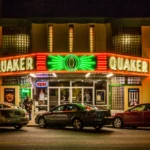Get ready to experience the movie magic at the newly renovated Regal Wekiva Riverwalk! This Apopka gem has everything you need for an amazing night out, featuring the latest blockbusters and classic films, all showcased with top-notch technology and comfy seating. Plus, there’s plenty of tasty snacks and drinks to keep you satisfied. So gather your crew, grab some popcorn, and dive into the world of cinema at Regal Wekiva Riverwalk—the perfect spot to escape, hang out, and create lasting memories.
From United Artists to Regal: A Cinematic Evolution
Remember the old United Artists Wekiva? Well, hold onto your popcorn because it has gone through a major transformation, emerging as the dazzling Regal Wekiva Riverwalk! Located at 2141 North Semoran Boulevard, Regal Wekiva Riverwalk is now the go-to destination for movie buffs in Apopka.
But this isn’t just a name change—it’s a complete cinematic makeover. Imagine sinking into plush recliner seats, feeling like royalty while munching on your favorite movie snacks. And with a diverse movie selection, from action-packed blockbusters to thought-provoking indie films, there’s something for every taste.
Regal Wekiva Riverwalk also prioritizes accessibility, ensuring everyone can enjoy the movies, regardless of physical limitations. Plus, they’re all about that community spirit, always hosting special events, offering discounts, and partnering with local Apopka businesses.
Ready for a night of entertainment? Grab your movie buddies and head on over to Regal Wekiva Riverwalk. You’ll quickly see how movies were meant to be experienced!
What Ever Happened to United Artists?
The story of United Artists (UA) is a captivating blend of innovation, rebellion, and Hollywood’s ever-changing landscape. Founded in 1919 by industry giants Charlie Chaplin, Mary Pickford, Douglas Fairbanks, and D.W. Griffith, UA challenged the established studio system by giving filmmakers unprecedented creative control and financial independence.
This radical approach led to a legacy of groundbreaking films, including classics like “Some Like It Hot,” “Rocky,” and “Midnight Cowboy.” UA’s willingness to take risks and champion unique voices cemented its place as a champion of independent filmmaking.
However, UA’s journey was not without its share of turbulence. Financial struggles and internal disagreements plagued the studio throughout its history. By 1981, facing significant debt, UA was acquired by Metro-Goldwyn-Mayer (MGM), marking the end of its run as a truly independent entity.
Despite its absorption, the United Artists name has been revived several times, often associated with ventures seeking to recapture the spirit of filmmaker-driven storytelling. Today, United Artists Releasing, a partnership between MGM and Annapurna Pictures, carries the torch, distributing films that embody UA’s legacy of creative vision and bold filmmaking.
The story of United Artists serves as a reminder of the delicate balance between artistic vision and financial realities in Hollywood. It’s a testament to the enduring power of independent spirit and the profound impact it can have on the world of cinema.
What Was United Artists Known For?
United Artists (UA) carved a unique path in Hollywood history, becoming synonymous with artistic freedom and groundbreaking cinema. Founded in 1919 by four of the biggest names in the industry—Charlie Chaplin, Mary Pickford, Douglas Fairbanks, and D.W. Griffith—UA challenged the established studio system by prioritizing the vision of its artists.
Instead of controlling every aspect of production, UA functioned primarily as a distributor and financier, giving independent filmmakers, including its founders, unprecedented creative control and ownership over their projects. This radical approach fostered a culture of innovation and risk-taking, leading to a string of iconic films that pushed boundaries and captivated audiences.
From the witty dialogue and undeniable charm of “Some Like It Hot” to the raw emotional power of “Rocky,” UA consistently championed distinctive voices and stories that resonated deeply with viewers. The studio’s willingness to back unconventional projects helped redefine cinematic storytelling and pave the way for generations of independent filmmakers.
Despite its successes, UA’s journey was not without its challenges. Financial instability and internal conflicts often cast shadows over its accomplishments. However, even after its acquisition by MGM in 1981, UA’s influence on Hollywood remained undeniable. The studio’s legacy serves as a powerful reminder that when artists are empowered to pursue their visions, the possibilities for cinematic excellence are limitless.
- Jerry McSorley’s Post-Divorce Life: New Beginnings - July 16, 2025
- The Rise and Fall of the New Haven Nighthawks: A Minor League Hockey Legacy - July 16, 2025
- Unlock Jerry McSorley’s Career Highlights: Eye Tax Inc.’s Solar Success - July 16, 2025

















1 thought on “United Artists Wekiva Transformed: Your Guide to Regal Wekiva Riverwalk”
Comments are closed.